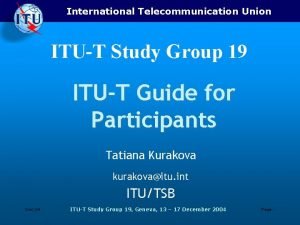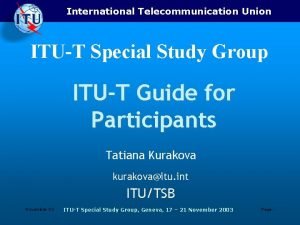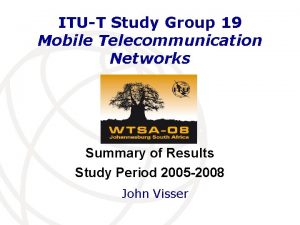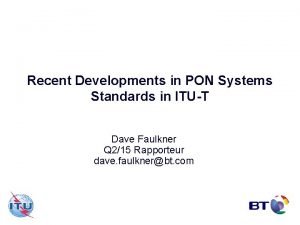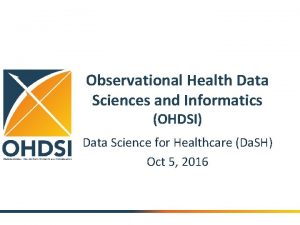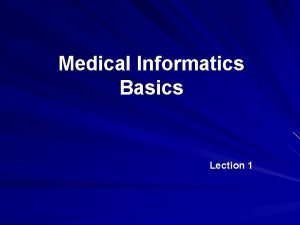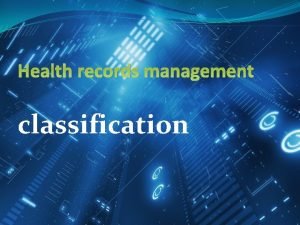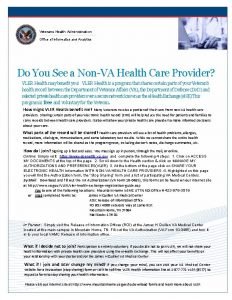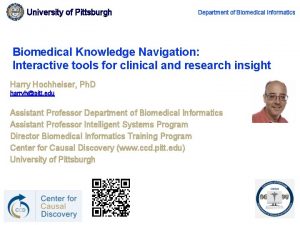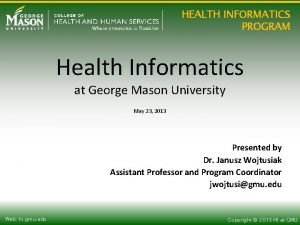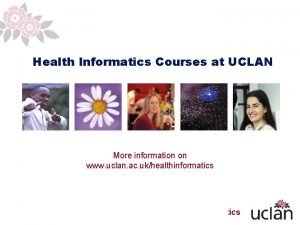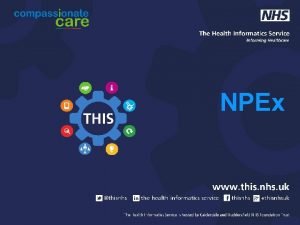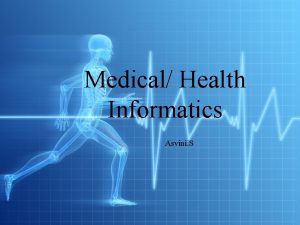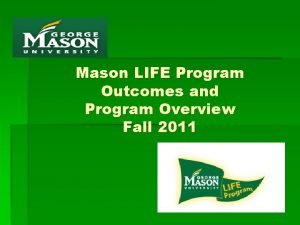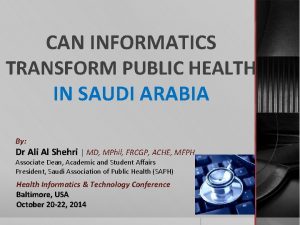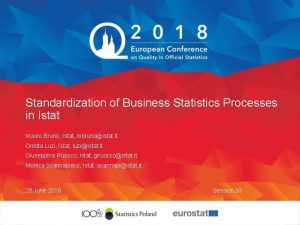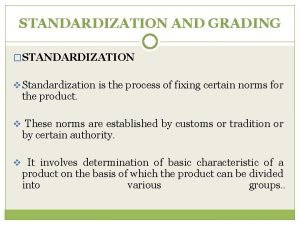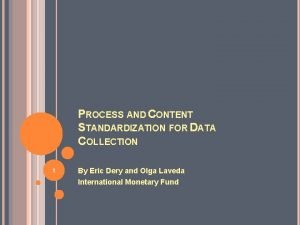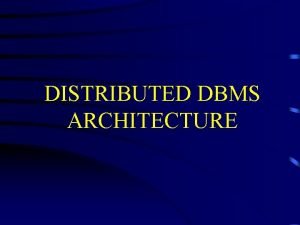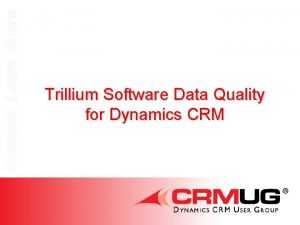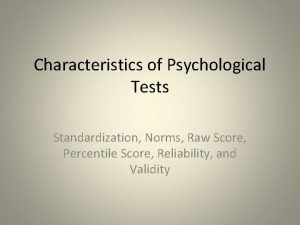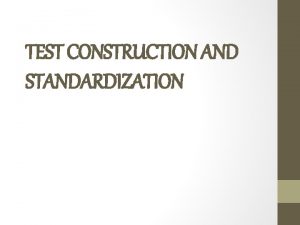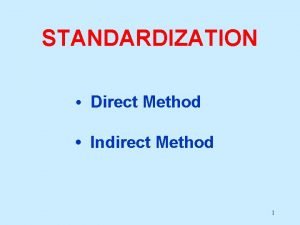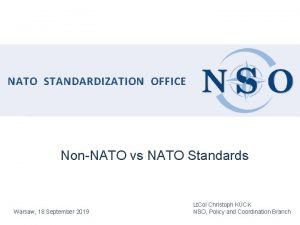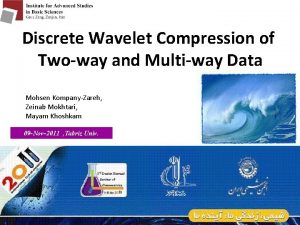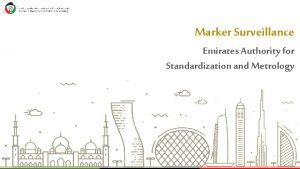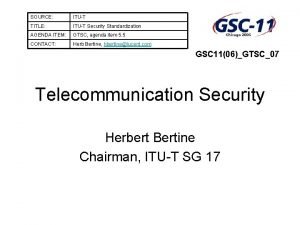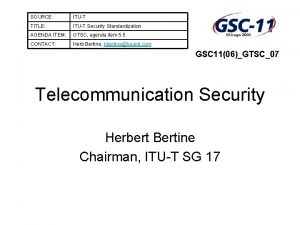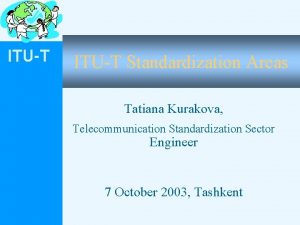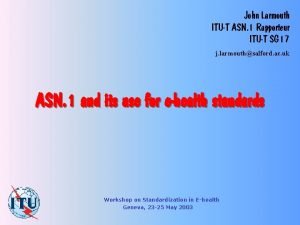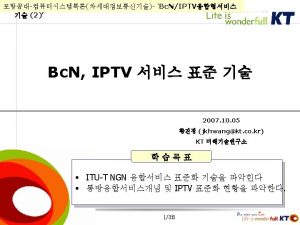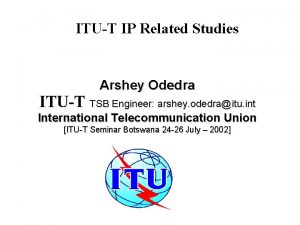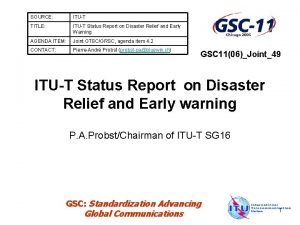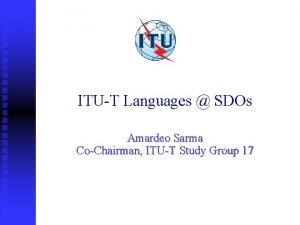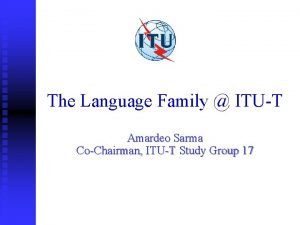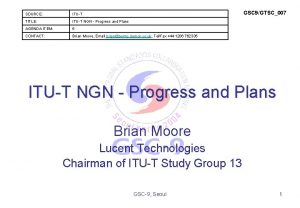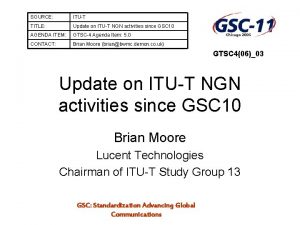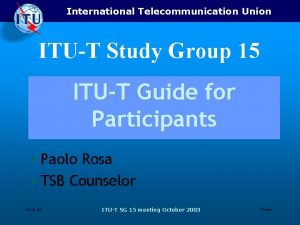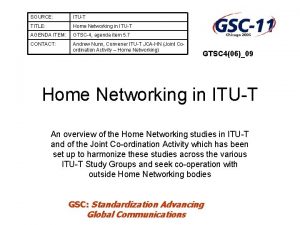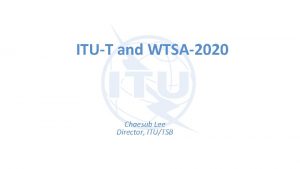European Standardization of Health Informatics ITUT e Health




































- Slides: 36

European Standardization of Health Informatics ITU-T e. Health conference Geneva 2003 -05 -23 Dr Gunnar O. Klein chairman of CEN/TC 251 convenor of ISO/TC 215/WG 4 Karolinska Institutet & Swedish Standards Institute gunnar. klein@sis. se

Content • Perspectives on the benefits of standards for health on-line • Overview of CEN/TC 251 work • Collaborating international bodies

Knowledge Outcomes Patient history Treatment plans Information management is central to modern healthcare Laboratory Staff Supplies Financial Referrals

Managing information is largely about communicating • between different staff members within a unit (multiprofessional teams and over time) • between units GP Hospital • between the patient and the professionals

A Communicating Health System • All health information is made available for continous care • Knowledge based systems are interacting with patient data • Effective co-operation between professionals • Active patients are a part • All patient cases can be used to generate new knowledge

Standards are Essential for enabling Health on-line • Improve Efficiency by enabling Professional Co-operation in new ways • Facilitate Integration of modular systems from different suppliers • Lower costs and facilitate procurement • Support Quality Management and Research with aggregated data

e. Europe An Information Society For All The Action Plan of the European Commission includes Health on-line as one of the key areas: “ To develop an infrastructure of interoperable systems for medical care, disease prevention and health education through national and regional networks which connect citizens, practitioners and authorities on-line. ”

Standards a Key to Interoperability Primary care Secondary care Insurance bodies Community care National/regional planning for public health Pharmacies Research Laboratories Patients

Standards should exist, be validated, well-known and implemented by major actors to enable: • The transfer of most types of patient centered information between all European healthcare organisations including complete health records, medicine prescriptions, referrals and results of all types of investigations performed. • Support of multimedia communication for the above purposes and including direct videoconferencing • The safe integration of also wireless medical devices of all types capable of information provision or in need of computer control from external health systems.

Standards requirements continued: • The integration of various knowledge sources available crossborder in multilingual form with the patient centered health information systems • To meet the security requirements for confidentiality, integrity (including electronic signatures added to various document parts), availability and accountability.

Standards requirements continued: • To allow interoperability and where appropriate, policy bridging to ensure that security, including access control between healthcare organisations also cross-borders with pan-European recognition of digital certificates of professional qualifications and registration. • This should also allow the patient in his home using internet and appropriate security techniques to be directly accessing health professionals and data pertaining to the patient. • The build up of appropriate quality control measures with in certain cases appropriate third party testing and certification of the health information systems to protect patient safety and to ensure interoperabilty of products

Different reasons to want standards for different actors • Healthcare providers (Hospitals, doctors and other professionals) – Enable interoperability between different units and systems to increase efficiency of care – Lower costs for buying systems by having a large competitive (international) market • Systems suppliers (software companies) – Enable the provision of modular systems where one product can tie into the total needs of the customers – Large market for their ”standard” product – less maintenance problems than with customer specific special solutions

Standards and authorities • Public health authorities in many countries sees standards as an important way of increasing the efficiency of the sector – Leading to better quality with minimum resources. In many western countries healthcare expenditures are not increasing anymore • Standards enable the collection of statistical information for surveillance and planning purposes • Standards for Informatics may help the authorities to excert quality control of health care information systems and medical devices. We are moving towards certification of software.

Standardization Activity of establishing, with regard to actual or potential problems, provisions for common and repeated use, aimed at the achievement of the optimum degree of order in a given context Definition from ISO/IEC Guide 2

The context • Karolinska Hospital • Stockholm region • Sweden • Europe • The World

In Europe we decided in 1990 that many of the issues that needed standards for health informatics would best be solved on a European scale rather than national There was no international work and it was felt that there was a need to support one internal market for IT products in all of the European Union. There is also a large number of citizens moving between these countries for work, studies and vacation. Interoperability of health information systems was desired

Standardization of Health Informatics in Europe CEN = Comité Européen de Normalisation European Committee for Standardization 22 EU and EFTA countries are members + candidate observers CEN/TC 251 Technical Committee on Health Informatics Secretariat is managed by SIS - Swedish standards institute www. centc 251. org

A political mandate and financial support from EU and EFTA • EU and EFTA policies have given CEN a mandate to produce standards for Healthcare Informatics in Europe • A small funding from CEC mainly for co-financing of project teams and central co-ordination. 1998 -2001, 500 k. EUR/year • European funding has been extremely important in speeding up the process

Development of standardized IT solutions HEALTHCARE User Requirements and domain experts IT-products User Requirements and domain experts R&D Universities Providers Industries -----EU Commission (IST-programme) Technical Solutions Standardization National Standards Bodies --------CEN/TC 251 --------ISO/TC 215, IETF etc Standards Industry Suppliers Expert knowledge 2

CEN/TC 251 working groups and convenors • I: Information models – Gerard Freriks, Netherlands • II: Terminology and knowledge bases – Göran Holmberg, Sweden • III: Security, Safety and Quality – Gilles Trouessin, France • IV: Technology for interoperability – Melvin Reynolds, UK

Working Group I: Information Models • Electronic Health Records • General Purpose Information Components • Messages for various purposes including e-prescriptions • Service architecture for health information interchange • Patient Data Cards

ENV 13606: 1999 • Health informatics - Electronic healthcare record communication – Part 1: Extended Architecture – Part 2: Domain Termlist – Part 3: Distribution Rules – Part 4: Messages for the Exchange of Information

Electronic Health Record Standards Development • EN 13606 Task force is working under the leadership of Dipak Kalra • The prestandard is developed based on existing experiences and the new ideas on a dual model approach – A reference information model – A template/archetype for specific uses • Collaboration with the Open Electronic Health Record Foundation

Health informatics - General Purpose Information Components Part 1: Overview Part 2: Non-clinical information Part 3: Clinical information These use: Health informatics – Data types • This is an essential core for all future information models in CEN for Messaging, Records and HISA. • This is a result of the harmonisation with HL 7 • GPICs has been submitted to ISO • Service request and report messages – Part 1: Basic Services including referral and discharge Now RFC

EN 12967 -1 • Health informatics – Service architecture Part 1: Enterprise viewpoint Part 2: Information viewpoint Part 3: Computational viewpoint • The revision is based on the existing ENV (HISA) and the Short strategic study Health Information Infrastructure. The model is using ISO/IEC 10746 Open distributed processing – reference model as a basis for the description.

Working Group II: Terminology and Knowledge bases • Semantic organisation of information and knowledge • Terms, concepts and interrelationships of concepts • Guidelines for the production of coding systems and knowledge bases • Systematisation of the semantic structure behind the names of compositions and headed sections of the health care record

Working Group III: Security, Safety and Quality • Guidelines for management of security for health • Detailed protocols for various core security services based on intersector standards. • Data protection in the context of the EU data protection directive, particularly for communication outside of Europe. • Access control policy bridging and systems for Anonymisation.

Working Group IV: Technology for interoperability • Intercommunication of data between devices and information systems – including clinical analysers, medical imaging and Intensive Care Unit equipment • Integration of data for multimedia representation • WG IV has an important collaboration with IEEE and ISO/TC 215 for Point-of. Care Medical Devices and with DICOM for imaging

ISO - collaboration with CEN ISO/TC 215 Health informatics was established in 1999 proposed by the US but with strong support from Europe

Vienna agreement between CEN and ISO • There are many examples with thousands of standards processed in collaboration between CEN and ISO. • The Vienna agreement intends to – Avoid duplication of effort and divergence – Allow parallel voting process where feasible • In health informatics a number of European prestandards ENVs have been the starting point for ISO/TC 215 work items – Vienna agreement allows the improved ISO documents to be processed in parallel as full European standards.

• CEN/TC 251 Health Informatics • ISO/TC 215 Health Informatics - WG I Information Models • - WG IV Technology for Interoperability • • - WGII Terminology and Knowledge Bases • - WG 1 Health Records and Modelling Co-ordination • • - WG 2 Messaging and Communication - WG 3 Health Concept Representation - WG III Security, Safety and Quality • - WG 4 Security • - WG 5 Health Cards - Task Force Cards

ISO - CEN joint work programme Collaboration with IEEE

ISO - CEN joint work programme

ISO - CEN work programme

ISO/TC 215 still only in the beginning of something very important • Many core areas dealing with information for specific messages or record structures have not been even started in ISO. With a few exceptions in the Po. C and Pki area there are no ISO standards available that can be used for implementations yet. • There is a continued need for work in some areas on a European scale and not the least nationally (e. g. to produce implementation guides of EN and IS) • ISO/TC 215 is an important vehicle for establishing international consensus

Global standardization of health informatics is welcomed by Europe because: • Joint work of the best experts of the world improves the quality of our standards • The market for industrial products (soft and particularly hard) should be more and more global although it must be recognized that for different reasons many systems are developed for national markets only • There is an emerging requirements for cross-border communication of health information which we want to support – BUT this need is still almost non-existent globally and small even within Europe
 Itut
Itut Itut
Itut Itut
Itut Cabs.itut
Cabs.itut Cabs itut
Cabs itut Observational health data sciences and informatics
Observational health data sciences and informatics Medical informatics definition
Medical informatics definition Health informatics
Health informatics Health informatics jobs
Health informatics jobs Va office of health informatics
Va office of health informatics Pitt health informatics
Pitt health informatics George mason university mha
George mason university mha Health informatics courses uk
Health informatics courses uk Health informatics career framework
Health informatics career framework Npex lims
Npex lims Health informatics ryerson
Health informatics ryerson Mason life program
Mason life program Health informatics in saudi arabia
Health informatics in saudi arabia Standardization statistics
Standardization statistics Difference between standardization and grading
Difference between standardization and grading Data standardization process
Data standardization process Milk standardization formula
Milk standardization formula Preparation and standardization of potassium permanganate
Preparation and standardization of potassium permanganate Standardization of outputs
Standardization of outputs Product and service design objectives
Product and service design objectives Global schema in distributed database
Global schema in distributed database Trillium crm
Trillium crm Standardization of psychological test
Standardization of psychological test Organic structure characteristics
Organic structure characteristics Satori address validation
Satori address validation Test construction and standardization
Test construction and standardization Standardized recipe
Standardized recipe Direct and indirect standardization
Direct and indirect standardization Nato standardization office
Nato standardization office Direct standardization example
Direct standardization example Emirates authority for standardization and metrology logo
Emirates authority for standardization and metrology logo Ibm maximo for oil and gas
Ibm maximo for oil and gas
